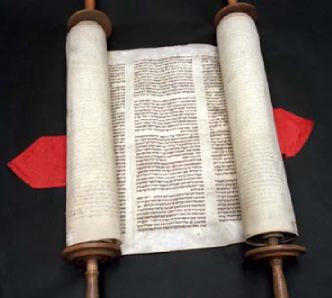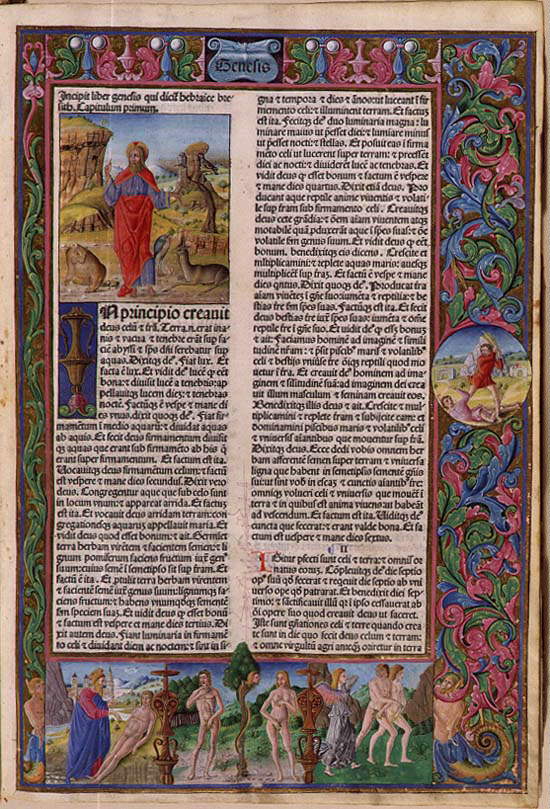Course Bibliography: Critical
Studies, More
Studies, Histories
of Interpretation, Commentaries,
Critical Studies (possible
book reports):
- Blum, E. Studien zur Komposition des Pentateuch.
BZAW 189. Berlin: de Gruyter, 1990.
- Carr, D. M. The Formation of the Hebrew Bible A
New Reconstruction. New York: Oxford, 2011.
- Carmichael, C. M. The Laws of Deuteronomy.
Ithaca, NY: Cornell University Press, 1974.
- Childs, B. S. Introduction to the Old Testament
as Scripture. Philadelphia: Fortress, 1979.
- Clines, D. J. A. The Theme of the Pentateuch.
JSOTSup 10; Sheffield: JSOT, 1978.
- Crüsemann, Frank. The Torah: Theology and Social
History of Old Testament Law. Tr. W. Mahnke.
Edinburgh/Minneapolis: Clark/Fortress, 1996.
- Friedman, R. E. The Exile and Biblical Narrative:
The Formation of the Deuteronomistic and Priestly
Works. HSM 22. Chico, CA: Scholars Press,
1981.
- Knohl, I. The Sanctuary of Silence: the Priestly
Torah and the Holiness School. Minneapolis:
Fortress, 1995.
- Levinson, Bernard M. Deuteronomy and the
Hermeneutics of Legal Innovation. New York:
Oxford University Press, 1997.
- Levinson, B. M. (ed.). Theory and Method in
Biblical and Cuneiform Law: Revision, Interpolation
and Development. JSOTSup 181. Sheffield:
Sheffield Academic Press, 1994.
- Mann, T. W. The Book of the Torah: the Narrative
Integrity of the Pentateuch. Atlanta: John Knox,
1988.
- McCarthy, D. J. Treaty and Covenant: A Study in
Form in the Ancient Oriental Documents and in the Old
Testament. 2nd rev. ed. Rome: Biblical Institute,
1981.
- Miles, J. God: A Biography. New York: Knopf,
1995.
- Mullen, E. T., Jr. Ethnic Myths and Pentateuchal
Foundations: A New Approach to the Formation of the
Pentateuch. SBLSS. Atlanta: Scholars Press,
1997.
- Nohrnberg, J. Like Unto Moses: the Constituting
of an Interruption. Bloomington: Indiana
University Press, 1995.
- Noth, M. A History of Pentateuchal Traditions
(originally published 1948). Trans. B. W. Anderson.
Chico, CA: Scholars Press, 1981.
- Olson, D. T. Deuteronomy and the Death of Moses:
A Theological Reading. OBT. Minneapolis: Fortress,
1994.
- Patrick, D. The Rhetoric of Revelation. OBT.
Minneapolis: Fortress, 1999.
- Paul, S. M. Studies in the Book of the Covenant
in the Light of Cuneiform and Biblical Law.
Leiden: E. J. Brill, 1970.
- Perlitt, L. Bundestheologie im Alten Testament.
WMANT 36. Neukirchen-Vluyn: Neukirchener Verlag,
1969.
- Polzin, R. Moses and the Deuteronomist: A
Literary Study of the Deuteronomic History. New
York: Seabury, 1980.
- Rad, G. von. ‘The Form-Critical Problem of the
Hexateuch.’ The Problem of the Hexateuch and Other
Essays. Trans. E. W. Trueman Dicken. Edinburgh:
Oliver & Boyd, 1966. Pp. 1-78.
- Rendtorff, R. The Problem of the Process of
Transmission in the Pentateuch. Trans. J. J.
Scullion. JSOTSup 89. Sheffield: JSOT Press, 1990.
- Sailhamer, J. H. The Pentateuch as Narrative: a
Biblical-Theological Commentary. Grand Rapids, MI:
Zondervan, 1992.
- Schmid, H. H. Der sogennante Jahwist. Zürich:
Theologisher Verlag, 1976.
- Sharpe, John, and Kimberly Van Kampen, eds. The
Bible as Book: The Manuscript Tradition. New
Castle, DE: Oak Knoll Press; London: The British
Library, 1998.
- Smend, R. Die Erzählung des Hexateuch auf ihre
Quellen untersucht. Berlin: G. Reimer, 1912.
- Smith, Mark S. The Pilgrimage Pattern in Exodus.
JSOTSup 239. Sheffield: Sheffield Academic Press, 1997.
- Sternberg, M. The Poetics of Biblical Narrative:
Ideological Literature and the Drama of Reading.
Bloomington, IN: Indiana University Press, 1985.
- Thompson, T. L. The Origin Tradition of Ancient
Israel: I. The Literary Formation of Genesis and
Exodus 1-23. JSOTSup 55. Sheffield: JSOT,
1987.
- Tigay, J. H. "The Evolution of the Pentateuchal
Narratives in the Light of the Evolution of the
Gilgamesh Epic," Empirical Models for Biblical
Criticism. Ed. J. H. Tigay; Philadelphia:
University of Pennsylvania Press, 1985. Pp. 21-52.
- Van Seters, J. Abraham in History and Tradition.
New Haven: Yale U.P., 1975.
- Van Seters, J. In Search of History. New
Haven: Yale University Press, 1983.
- Van Seters, J. The Life of Moses: The Yahwist as
Historian in Exodus-Numbers. Louisville:
Westminster John Knox, 1994.
- Watts, J. W. (ed.). Persia and Torah: the Theory
of Imperial Authorization of the Pentateuch. Symposium
Series. Atlanta: SBL, 2001.
- Weinfeld, M. Deuteronomy and the Deuteronomic
School. Oxford: Oxford University Press,
1972.
- Wellhausen, J. Prolegomena to the History of
Israel. Gloucester, MA: Peter Smith, 1973, orig.
1878.
- Whybray, R. N. The Making of the Pentateuch: A
Methodological Study. JSOTSup 53. Sheffield: JSOT
Press, 1987.
Other critical studies
(not an option for book reports):
- Alt, A. ‘The Origins of Israelite Law.’ Essays on Old
Testament History and Religion. Trans. R. A. Wilson.
Oxford: Blackwell, 1966. Pp. 81-31. [First published,
1934.]
- Brian Britt, “Moses, Monotheism, and Memory.” Religious
Studies Review 26/4 (2000) 313-17.
- Brooks, R. Spirit of the Ten Commandments.
New York: Harper & Row, 1990.
- Carr, David M. Writing on the Tablet of the
Heart: Origins of Scripture and Literature. New
York: Oxford, 2005.
- Cohn, Yehudah B. Tangled Up In Text:
Tefillin and the Ancient World. Providence: Brown
Judaic Studies, 2008.
- Damrosch, D. ‘Leviticus.’ In R. Alter and F. Kermode
(eds.). The Literary Guide to the Bible.
Cambridge, MA: Belknap/Harvard, 1987. Pp. 66-77.
- Damrosch, D. The Narrative Covenant:
Transformations of Genre in the Growth of Biblical
Literature. San Francisco: Harper & Row,
1987.
- Fretheim, T. E. The Pentateuch. Nashville:
Abingdon, 1996.
- Goldstein, G. M. “Torah Ornaments.” In The Oxford
Dictionary of the Jewish Religion. Ed. Werblowsky
and Wigoden. Oxford: Oxford University Press, 1997. 698.
- Green, William Scott. “Scripture in Classical
Judaism.” In The Encyclopedia of Judaism. Ed.
J. Neusner, S. Peck and W. S. Green. New York:
Continuum/Leiden: Brill, 1999. 1302-1309.
- Hamel, Christopher de. The Book: A History of the
Bible. New York: Phaidon, 2001.
- Koch, Klaus. ‘P - Kein Redaktor’. Vetus
Testamentum 37 (1987), pp. 446-67.
- Kraus, F. R. ‘Ein zentrales Problem des
altmesopotamischen Rechts: Was ist der Codex
Hammu-Rabi?’ Genava 8 (1960) 283-96.
- Marty, Martin. “America's Iconic Book,” in Humanizing
America's Iconic Book. Ed. Gene M. Tucker and
Douglas A. Knight. Chico: Scholars Press, 1982. 1-23.
- McEvenue, S. E. The Narrative Style of the
Priestly Writer. AnBib 50. Rome: Biblical
Institute, 1971.
- Mendenhall, G. E. ‘Ancient Oriental and Biblical
Law.’ In E. F. Campbell, Jr. and D. N. Freedman (eds.),
Biblical Archeologist Review 3. Garden City, NY:
Doubleday, 1970. Pp. 1-24.
- Mendenhall, G. E. ‘Covenant Forms in Israelite
Tradition.’ In E. F. Campbell, Jr. and D. N. Freedman
(eds.), Biblical Archeologist Review 3. Garden
City, NY: Doubleday, 1970. Pp. 25-53.
- Nasuti, H. P. ‘Identity, Identification, and
Imitation: the Narrative Hermeneutics of Biblical Law.’
Journal of Law and Religion 4/1 (1986), pp.
9-23.
- Noth, M. A ‘The Laws of the Pentateuch.’ The Laws
of the Pentateuch and Other Studies. Trans. D. R.
Ap-Thomas. Philadelphia: Fortress, 1967.
- Olson, D. T. The Death of the Old and the Birth
of the New: The Framework of the Book of Numbers and
the Pentateuch. BJS 71. Chico: Scholars Press,
1985.
- Patrick, D. Old Testament Law. Atlanta: John
Knox, 1985.
- Parmenter, Dorina Miller. “The
Iconic Book: The Image of the Bible in Early Christian
Rituals.” Postscripts 2 (2006), 160-189.
- Parmenter, Dorina Miller. “The Bible as Icon: Myths of
the Divine Origins of Scripture,” in Jewish and
Christian Scripture as Artifact and Canon (ed.
Craig A. Evans and H. Daniel Zacharias; London: T. &
T. Clark, 2009), 298-310.
- Roth, M. T. Law Collections from Mesopotamia and
Asia Minor. WAW 6. Atlanta: Scholars Press, 1995.
- Sabar, Shalom. “Torah and Magic: The Torah Scroll and
its Appurtenances as Magical Objects in Traditional
Jewish Culture.” European Journal of Jewish Studies
3 (2009), 135-70.
- Schleicher, Marianne. "Accounts of a Dying Scroll: On
Jewish Handling of Sacred Texts in Need of Restoration
or Disposal." In Myrvold, Death of Sacred Texts (2010),
11-30.
- Smith, Jonathan Z. “Religion and the Bible.” Journal
of Biblical Literature 128/1 (2009), 5-27.
- Stolow, Jeremy. Orthodox by Design: Judaism,
Print Politics, and teh ArtScroll Revolution. Berkeley:
University of California Press, 2010.
- Watts, James W. Ritual and Rhetoric in Leviticus:
From Sacrifice to Scripture, New York: Cambridge
University Press, 2007.
- Wellhausen, J. Die Composition des Hexateuchs und
der historischen Bücher des Alten Testaments. 4th
ed. Berlin: De Gruyter, 1963, orig. 1876-77.
Histories of Interpretation
- Harrison, Peter. The Bible, Protestantism, and
the Rise of Natural Science. Cambridge: Cambridge
U.P., 2001.
- Knight, Douglas A. and Gene M. Tucker, eds. The
Hebrew Bible and Its Modern Interpreters.
Philadelphia: Fortress/Chico: Scholars Press, 1985.
- Nicholson, Ernest W. The Pentateuch in the
Twentieth Century: The Legacy of Julius Wellhausen.
Oxford: Clarendon, 1998.
- Noll, Mark A. Between Faith and Criticism:
Evangelicals, Scholarship, and the Bible in America.
Harper & Row, 1986.
- Reventlow, Henning Graf. The Authority of the
Bible and the Rise of the Modern World. Tr. J.
Bowden. Philadelphia: Fortress, 1985.
- Sperling, S. David. Students of the Covenant: A
History of Jewish Biblical Scholarship in North
America. Atlanta Scholars Press, 1992.
- Sugirtharajah, R.S. The Bible and the Third
World: Precolonial, Colonial, and Postcolonial
Encounters. Cambridge: Cambridge U.P., 2001.
Commentaries:
- Westermann, Claus. Genesis 1-11, 12-36,
37-50. 3 vols. Minneapolis: Augsburg,
1984-86.
- Gunkel, Hermann. Genesis. 5th ed. Göttingen:
Vandenhoeck & Ruprecht, 1922. Reprinted and Trans.
by M. Biddle. Macon: Mercer University Press,
1997.
- Rad, Gerhard von. Genesis. OTL. Philadelphia:
Westminster,
- Wenham, Gordan. Genesis 1-15, 16-50. WBC 1-2.
Dallas: Nelson/Word, 1987.
- Childs, B. S. The Book of Exodus: A Critical,
Theological Commentary. OTL. Philadelphia:
Westminster, 1974.
- Houtman, Cornelis. Exodus. 3 vols. HCOT.
Kampen: Kok Pharos, 1999.
- Propp, William E. Exodus 1-18. AB 2. New
York: Doubleday, 1999.
- Dozeman, Thomas Exodus. The Eerdmans
Critical Commentary. Grand Rapids: Eerdmans, 2009.
- Milgrom, J. Leviticus 1-16, Leviticus 17-22,
Leviticus 23-27. AB 3. New York: Doubleday, 1991,
2000, 2001.
- Levine, Baruch. Leviticus/Va-yikra.
Philadelphia : Jewish Publication Society, 1989.
- Hartley, John E. Leviticus. WBC 3. Dallas:
Word, 1992.
- Watts, James W. Leviticus 1-10. HCOT.
Leuven: Peeters, forthcoming.
- Milgrom, Jacob. Numbers/Ba-midbar.
Philadelphia : Jewish Publication Society, 1990.
- Levine, Baruch. Numbers 1-20, Numbers 21-36.
AB 4. New York : Doubleday, 1993, 2000.
- Tigay, Jeffrey. Deuteronomy. Philadelphia:
Jewish Publication Society, 1996.
- Weinfeld, Moshe. Deuteronomy 1-11. AB .
New York: Doubleday, 1991
|



